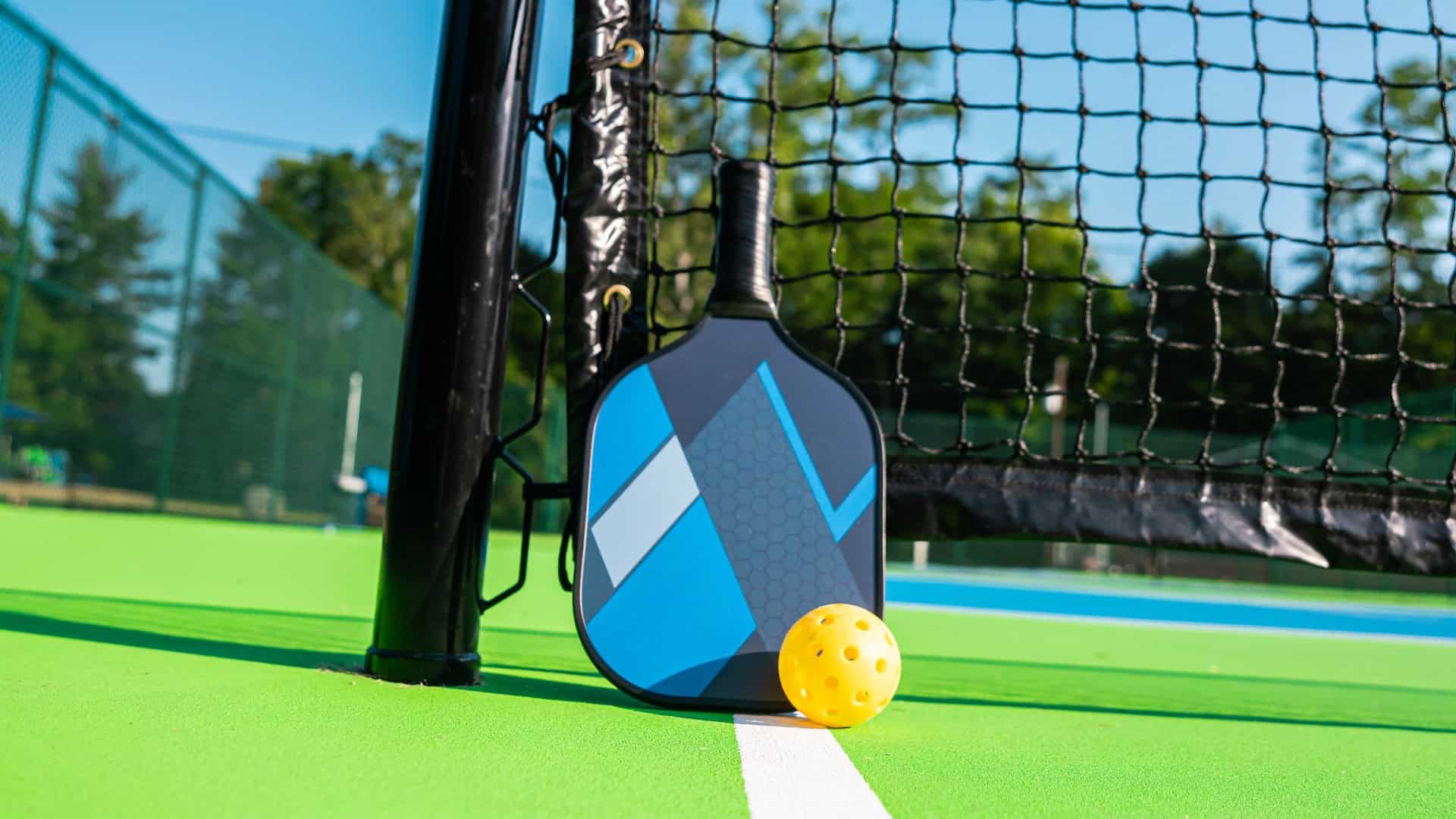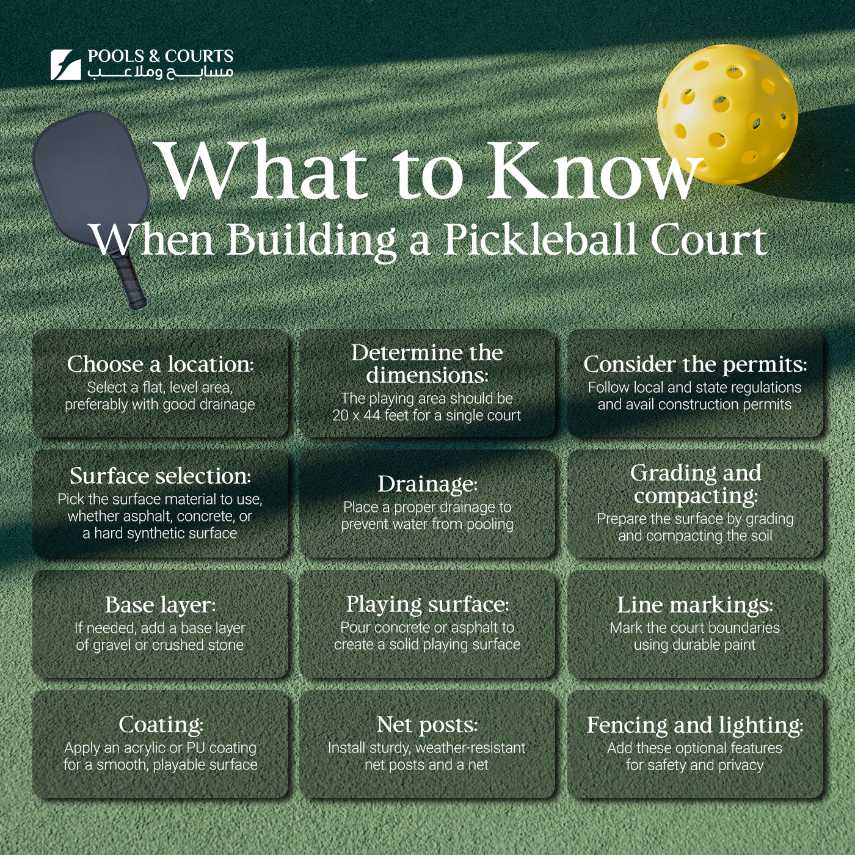How to Build Indoor and Outdoor Pickleball Courts in Saudi Arabia
Pickleball is quickly gaining popularity in schools, residential communities, and sports clubs across Saudi Arabia. As the game’s popularity grows, so does the demand for professionally built pickleball courts. Whether a stand-alone outdoor court or part of a larger multi-sport facility, a well-constructed court makes a big difference in safety, durability, and gameplay experience.

Looking for a trusted sports field contractor in Riyadh? Pools & Courts has over 40 years of experience building professional-grade sports courts across the Kingdom. If you want to build a pickleball court in Saudi Arabia, our team offers complete construction services, from site prep and surfacing to installation and aftercare.
Why Build a Pickleball Court?
Pickleball is accessible to all ages and skill levels, combining elements of tennis, badminton, and ping-pong. It’s relatively easy to learn and doesn’t require a large playing space, making it practical for many properties. As a sport, pickleball’s accessibility appeals to diverse age groups, making it popular in schools, residential areas, and retirement communities.
A standard single court requires only 20 x 44 feet of playing area, making it ideal for backyards, school campuses, or shared-use developments. Pickleball is a versatile sport that can be played indoors or outdoors, so it’s a sport you can play all year round. Additionally, pickleball courts can be designed for shared use with tennis or badminton to maximize the value of your investment.
Types of Pickleball Courts
Depending on the location and functional needs, there are two types of courts to consider: outdoor or indoor. Outdoor pickleball courts are typically built with UV-resistant surface coatings to withstand extreme temperatures, integrated net systems, and fencing for wind protection. Meanwhile, indoor pickleball courts usually have PU or vinyl flooring in a controlled environment.
General Technical and Environmental Considerations
When planning a pickleball court, several technical and environmental factors should be considered, such as:
Court Dimensions and Layout
The standard court size is 20 feet wide by 44 feet long, but an area of 30 feet by 60 feet is recommended for play and safety. There should be a buffer zone of at least 10 feet behind each baseline and 5 feet along the sidelines. The net should be 22 feet wide, 36 inches high at the posts, and 34 inches high at the center. Additionally, there should be 2-inch-wide lines marking the boundaries, service areas, and non-volley zones.
Surface Materials and Construction
Several types of surface materials are used for pickleball courts, including concrete, which is long-lasting and stable and is often used for outdoor courts. Asphalt is another standard surface material, although it’s less durable under high heat. Synthetic materials such as PU or acrylic coatings can be used for outdoor courts, offering excellent grip and weather resistance.
Indoor Court Requirements
An indoor pickleball court must have a ceiling height of 18 to 20 feet for safe and unobstructed play. Ventilation is important for maintaining air quality in humid indoor settings, while shadow-free LED lighting is preferred for consistent visibility. Indoors, PU flooring offers shock absorption, traction, and durability.
Considerations for Building a Court in Saudi Arabia
In addition to sport-specific requirements, there are other factors to consider when building a sports court in the region:
Extreme climate: Surface coatings, structural elements, and base layers must tolerate prolonged heat exposure without cracking or warping.
Dust and sand exposure: Outdoor courts should use dust-resistant coatings with surfaces that are easy to clean after dust storms.
Drainage and site preparation: Proper slope, sub-base compaction, and water management systems should be considered to prevent surface damage after rainfall.
Lighting design: Courts used after dark should have weather-resistant LED lighting systems for consistent brightness.
Regulatory compliance: Local building codes and zoning requirements should be followed, depending on the site location. Make sure to obtain the proper permits to ensure full compliance before construction.
How to Build a Pickleball Court
At Pools & Courts, we follow a systematic construction process to deliver high-quality pickleball courts.
1. Planning and preparation
Choose a location: Select a flat, level area, preferably with good drainage. A North-south orientation is generally best for outdoor courts to reduce sun interference.
Determine the dimensions: While the playing area is 20 x 44 feet, a larger area of 30 by 60 feet is recommended.
Consider the permits: Check local and state regulations regarding permits for construction.
Surface selection: Choose whether to use asphalt, concrete, or hard synthetic surface material.
Drainage: Ensure there’s proper drainage to prevent water from pooling.
2. Construction
Grading and compacting: Prepare the surface by grading and compacting the soil.
Base layer: If needed, add a base layer of gravel or crushed stone.
Playing surface: Pour concrete or asphalt to create a solid playing surface.
Line markings: Use durable paint to mark the court boundaries.
Coating: Apply an acrylic or PU coating for a smooth, playable surface with traction.
3. Completion
Net posts: Install sturdy, weather-resistant net posts that can withstand tension.
Fencing and lighting: These optional features add safety and privacy.


Choose a Professional to Build Your Pickleball Court
Want to make sure the construction process goes smoothly? Consider hiring professionals to ensure proper adherence to guidelines and quality workmanship that lasts. For well over four decades, Pools & Courts has provided full-service capabilities in building sports courts for residential, commercial, and institutional use. From planning to construction, we take care of all the nitty-gritty details, so you won’t have to.
If you’re developing a multi-use sports facility or installing a court in your neighborhood, Pools & Courts provides the reliable technical expertise, logistical support, and quality materials needed for world-class construction. Contact us for a quotation.
References:
- The Ultimate Guide to Building a Private Pickleball Court. Retrieved on 19 June 2025 from https://aibd.org/the-ultimate-guide-to-building-a-private-pickleball-court/
- Do It Yourself Guidelines. Retrieved on 19 June 2025 from https://usapickleball.org/what-is-pickleball/courts-and-construction/do-it-yourself-guidelines/

